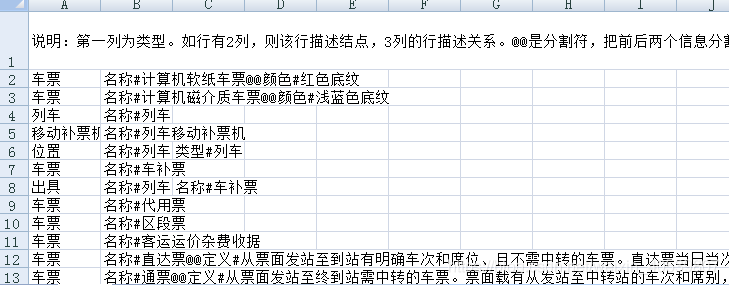菜哥学知识图谱(通过“基于医疗知识图谱的问答系统”)(八)(知识存储)
上接菜哥学知识图谱(通过“基于医疗知识图谱的问答系统”)(七)(知识图谱设计、知识抽取1)
先跳过机器学习方式抽取知识。在人工标注信息后,将知识录入到图数据库中。
1.人工知识抽取
将“出行指南”模块的第一部分“车票”的内容先复制下来。

人工标注信息(这是个csv文件):

2.将知识写入到图数据库中。先要把vc++14装上,不装还是不方便。
代码:
# 读取csv文件,生成Cypher语言并写入图数据库
# -*- coding: utf-8 -*-
import csv
from py2neo import Graph, Node
class MAIN:
def __init__(self):
# 创建实例
self.g = Graph(
host="127.0.0.1", # neo4j 搭载服务器的ip地址,ifconfig可获取到
http_port=7474, # neo4j 服务器监听的端口号
user="neo4j", # 数据库user name,如果没有更改过,应该是neo4j
password="neo4jzl")
def write(self, csvfile, message): # 写入csv数据
newfile = open(csvfile, 'a+', newline='')
filewriter = csv.writer(newfile)
filewriter.writerows(message)
def open(self, file):
self.file = file
with open(self.file, 'r') as f:
self.reader = csv.reader(f)
self.messages = list(self.reader)
print(self.messages)
def tra_attribute(self): # 经测试,neo4j的类型名、属性内容可以是中文,但属性名必须是英文。因此先要把所有的属性名全部翻译成英文。
list_attribute = []
for messages in self.messages[1:]:
for message in messages:
if r'#' in message:
for i in message.split(r'@@'):
if r'#' in i:
node_attribute = i.split(r'#')
list_attribute.append(node_attribute[0])
list_attribute = list(set(list_attribute))
lists_attribute = []
for i in list_attribute:
j = []
j.append(i)
j.append('')
lists_attribute.append(j)
self.write(csvfile='C:\\chouquxinxi\\出行指南\\属性名.csv', message=lists_attribute)
# 后面需要手动打开该文件,手动翻译属性名,写在第二列。弄了半天自动翻译没弄成,有点尴尬。
def cypher_make_send(self): # 核心方法
# 读取翻译结果
dict_attribute = {}
with open('C:\\chouquxinxi\\出行指南\\属性名.csv', 'r') as f:
reader = csv.reader(f)
for l in reader:
dict_attribute[l[0]] = l[1]
# 判断每行数据信息
for message in self.messages[1:]:
if len(message) == 2 or message[2] == '': # 2列信息描述结点
node_type = message[0] # 节点类型
node_attributes = message[1] # 节点属性
dict_node_attribute = {} # 属性字典,下面做这个字典
for i in node_attributes.split(r'@@'):
node_attribute = i.split(r'#') # 节点属性分段,node_attribute[0]属性名,node_attribute[1]属性值
node_attribute[0] = dict_attribute[node_attribute[0]] # 属性名翻译为英文
dict_node_attribute[node_attribute[0]] = node_attribute[1] # 转为字典
# print(dict_node_attribute)
if '名称' in node_attributes: # 如果这一条信息里面有“名称”字样,则说明该信息是对单个节点进行操作。
# 准备这么操作:建立该节点,然后一条属性一条属性的添加
namevalue = dict_node_attribute.pop('name') # 删除要删除的键值对"name",返回值是删除的值name的内容。剩下的就是需要创建或修订的其他属性
cypher = "MERGE (m:%s { name: '%s' }) RETURN m.name" % (node_type, namevalue)
# 上一句的意思是,如果该节点类型、名称不存在,则创建该节点。
re = self.g.run(cypher).data()
print("-->节点<--新建节点:%s" % (re))
for key, value in dict_node_attribute.items():
cypher = "MERGE (m:%s { name: '%s' }) \
ON MATCH SET m.%s = '%s' \
RETURN m.%s" % (node_type, namevalue, key, value, key)
re = self.g.run(cypher).data()
print("-->节点<--'%s':新建或修改属性:%s" % (namevalue, re))
else: # 如果不包含“名称”字样,则说明该信息是所有该类型的节点进行操作
for key, value in dict_node_attribute.items():
cypher = "MERGE (m:%s) \
ON MATCH SET m.%s = '%s' \
RETURN m.%s" % (node_type, key, value, key)
re = self.g.run(cypher).data()
print("-->节点<--新建或修改属性:%s" % (re))
elif len(message) == 3: # 3列信息描述关系
relationships = message[0] # 关系
dict_relationships = {} # 关系字典,下面做这个字典
if r'@@' in relationships: # 如果包含分割符,说明包含属性,此时需要把属性读取出来
list_relationships = relationships.split(r'@@')
dict_relationships['type'] = list_relationships[0] # 关系类型
for i in list_relationships[1:]:
relationships_attribute = i.split(r'#')
relationships_attribute[0] = dict_attribute[relationships_attribute[0]] # 属性名翻译为英文
dict_relationships[relationships_attribute[0]] = relationships_attribute[1] # 转为字典
else:
dict_relationships['type'] = relationships
node_start = message[1] # 起节点
dict_node_start = {} # 起节点属性字典,下面做这个字典
for i in node_start.split(r'@@'):
node1_attribute = i.split(r'#')
node1_attribute[0] = dict_attribute[node1_attribute[0]] # 属性名翻译为英文
dict_node_start[node1_attribute[0]] = node1_attribute[1] # 转为字典
node_end = message[2] # 止节点
dict_node_end = {} # 止节点属性字典,下面做这个字典
for i in node_end.split(r'@@'):
node2_attribute = i.split(r'#') # 节点属性分段,node_attribute[0]属性名,node_attribute[1]属性值
node2_attribute[0] = dict_attribute[node2_attribute[0]] # 属性名翻译为英文
dict_node_end[node2_attribute[0]] = node2_attribute[1] # 转为字典
#下面开始写语句
start_type = ''
start_attribute = ''
if 'type' in dict_node_start: # 如果包含类型
start_type = ":%s" % (dict_node_start['type'])
dict_node_start.pop('type')
for key, value in dict_node_start.items():
start_attribute = start_attribute + "%s:'%s'" % (key, value) + ','
if start_attribute == '':
cypher_node_start = start_type
else:
cypher_node_start = start_type+'{'+start_attribute[:-1]+'}' #[:-1]把最后一个逗号去掉
end_type = ''
end_attribute = ''
if 'type' in dict_node_end: # 如果包含类型
end_type = ":%s" % (dict_node_end['type'])
dict_node_end.pop('type')
for key, value in dict_node_end.items():
end_attribute = end_attribute + "%s:'%s'" % (key, value) + ','
if end_attribute == '':
cypher_node_end = end_type
else:
cypher_node_end = end_type + '{' + end_attribute[:-1] + '}'
relationships_type = ''
relationships_attribute = ''
if 'type' in dict_relationships: # 如果包含类型
relationships_type = ":%s" % (dict_relationships['type'])
dict_relationships.pop('type')
for key, value in dict_relationships.items():
relationships_attribute = relationships_attribute + "%s:'%s'" % (key, value) + ','
if relationships_attribute == '':
cypher_relationships = relationships_type
else:
cypher_relationships = relationships_type + '{' + relationships_attribute[:-1] + '}'
cypher = " MATCH(m" + cypher_node_start + "),(n" + cypher_node_end + ") MERGE(m)-[r" + cypher_relationships +"]->(n) RETURN m,n,r"
re = self.g.run(cypher).data()
print("-->关系<--新建或修改关系:%s" % (re))
if __name__ == '__main__':
file = 'C:\\chouquxinxi\\出行指南\\车票.csv'
read = MAIN()
read.open(file=file)
#read.tra_attribute() #第一步,运行完毕后手动翻译
read.cypher_make_send() #第二步
几个重点:
1.tra_attribute()方法是将中文属性名写入一个文件,然后需要手动翻译一下,中文翻译为英文。有时间会做一个自动翻译方法。
2.类型名不能带引号。
3.知识融合问题。主要用到cypher语言“MERGE”关键字,该关键字的作用是已有(属性名、关系)的话修改,没有的话创建。这样就把知识融合、知识存储统一到一句cypher语句中了,不用通过程序反复查询、判断。变量cypher是最终的语句,可以打印输出,查看一下生成的语句的构成。
其他的注释的比较清楚,就不多说。
运行注意事项:
1.需要先修改代码里面的几个文件车票.csv、属性名.csv地址,改为放到本机文件的位置。
2.提前打开neo4j.bat console,打开数据库。可提前清空该数据库中的内容,具体语句CSDN可搜索。
3.最下面第一步我已经翻译过了,可以直接运行第二步。
代码是通用代码,不指定具体的内容形式,只要按车票.csv中的格式标注,任何内容都可以存贮到图知识库中。
文章不再更新……最尴尬的是论文拿去了,职称评审组的说我根据的职责,需要考国家计算机考试……